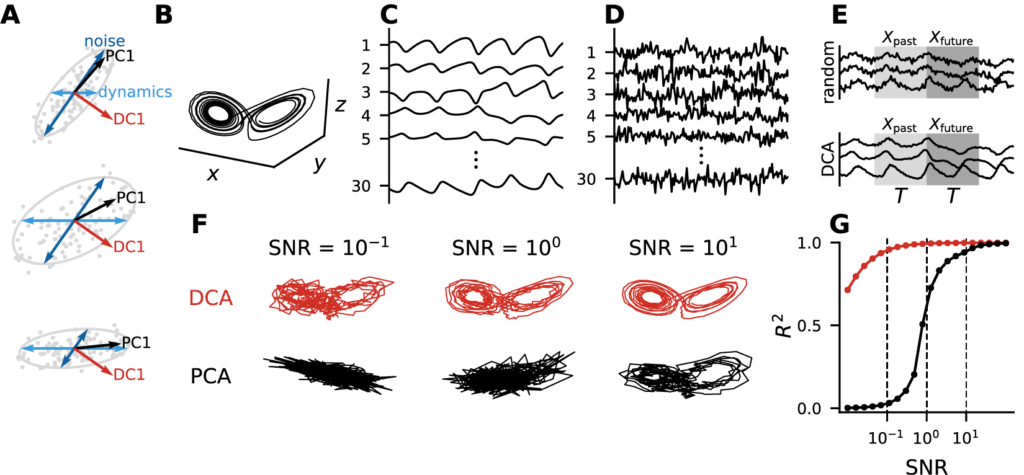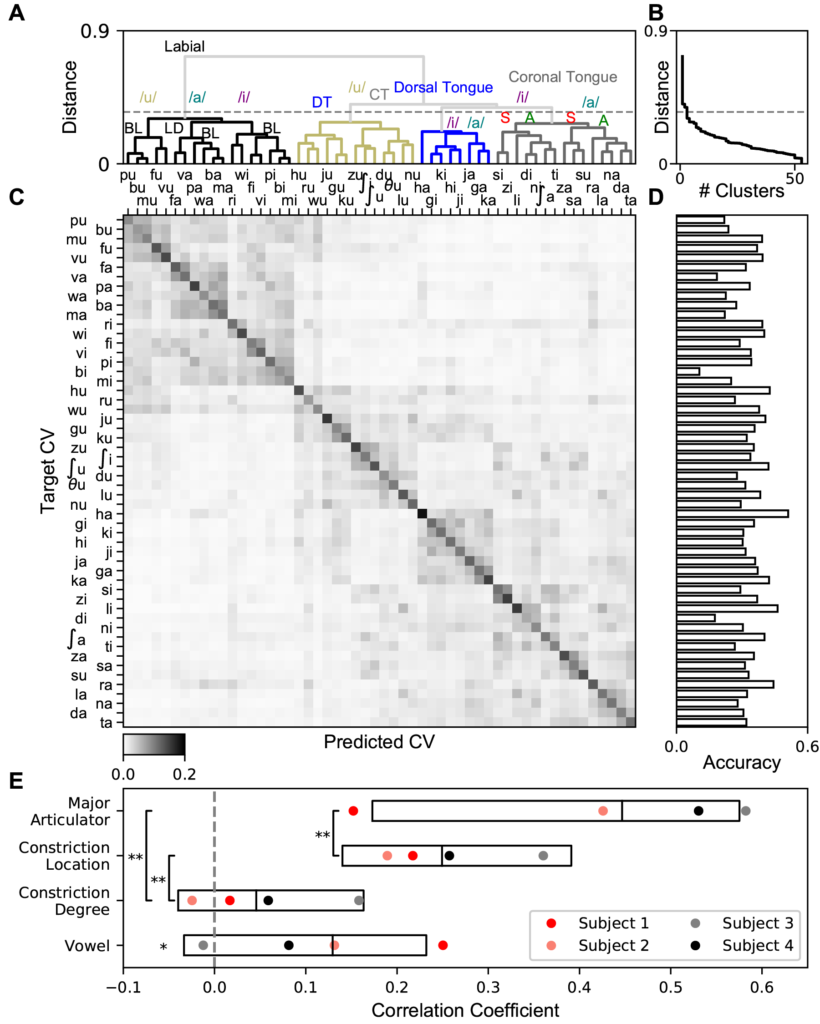For neural timeseries data, I have developed a linear method for dimensionality reduction (Dynamical Components Analysis) that uses prediction (predictive information) as a criterion. I have also worked on better understanding cost functions for controlling the coherence of an overcomplete dictionary in an ICA model.

I have also used deep learning to understand the structure of neural data recorded during human speech production. Since deep learning is becoming a commonly used method in neuroscience data analysis and modeling, I have also worked to develop benchmark datasets to better understand how deep networks learn hierarchical and compositional structure from datasets.

Recently, I have worked to investigate a model of neural shared variability and its implications for neural coding. I’m currently investigating common measures of neural coding and their implications for neural data.
You can find my CV here, a list of publications organized thematically below, and my Google Scholar page should have an up-to-date list.
Publications, Preprints, and Technical Reports
Neuroscience, Computational Neuroscience, and Machine Learning for Neuroscience
Sachdeva, P. S., Livezey, J. A., & DeWeese, M. R. (2020). Heterogeneous synaptic weighting improves neural coding in the presence of common noise. Neural Computation, 32(7), 1239-1276. (pdf) https://doi.org/10.1162/neco_a_01287.
Clark, D.*, Livezey, J.*, & Bouchard, K. (2019). Unsupervised discovery of temporal structure in noisy data with dynamical components analysis. In Advances in Neural Information Processing Systems (pp. 14267-14278).
Livezey, J. A., Bouchard, K. E., & Chang, E. F. (2019). Deep learning as a tool for neural data analysis: speech classification and cross-frequency coupling in human sensorimotor cortex. PLoS computational biology, 15(9), e1007091. https://doi.org/10.1371/journal.pcbi.1007091
Livezey, J. A., & Glaser, J. I. (2020). Deep learning approaches for neural decoding across architectures and recording modalities. (accepted version) arXiv preprint arXiv:2005.09687.
Sachdeva, P. S., Livezey, J. A., Dougherty, M. E., Gu, B. M., Berke, J. D., & Bouchard, K. E. (2020). Accurate inference in parametric models reshapes neuroscientific interpretation and improves data-driven discovery. bioRxiv.
Clark, D. G., Livezey, J. A., Chang, E. F., & Bouchard, K. E. (2018). Spiking Linear Dynamical Systems on Neuromorphic Hardware for Low-Power Brain-Machine Interfaces. arXiv preprint arXiv:1805.08889.
Machine Learning
Livezey, J. A., Bujan, A. F., & Sommer, F. T. (2019). Learning Overcomplete, Low Coherence Dictionaries with Linear Inference. Journal of Machine Learning Research, 20(174), 1-42. https://jmlr.org/papers/v20/18-703.html.
Livezey, J. A., Hwang, A., & Bouchard, K. E. (2019). Hangul Fonts Dataset: a Hierarchical and Compositional Dataset for Interrogating Learned Representations. arXiv preprint arXiv:1905.13308.
Theano Development Team including Livezey, J. (2016). Theano: A Python framework for fast computation of mathematical expressions. arXiv, arXiv-1605.
Cheung, B., Livezey, J. A., Bansal, A. K., & Olshausen, B. A. (2014). Discovering hidden factors of variation in deep networks. arXiv preprint arXiv:1412.6583.
Software
Sachdeva, P. S., Livezey, J. A., Tritt, A. J., & Bouchard, K. E. (2019). PyUoI: The Union of Intersections Framework in Python. Journal of Open Source Software, 4(44), 1799.
Physics Education
Berggren, C., Gandhi, P., Livezey, J. A., & Olf, R. (2018). A tale of two slinkies: Learning about model building in a student-driven classroom. The Physics Teacher, 56(3), 134-137. (pdf) https://doi.org/10.1119/1.5025285.
Gandhi, P. R., Livezey, J. A., Zaniewski, A. M., Reinholz, D. L., & Dounas-Frazer, D. R. (2016). Attending to experimental physics practices and lifelong learning skills in an introductory laboratory course. American Journal of Physics, 84(9), 696-703. (arXiv) https://doi.org/10.1119/1.4955147.
Accelerator Physics
Calvey, J. R., Hartung, W., Li, Y., Livezey, J. A., Makita, J., Palmer, M. A., & Rubin, D. (2015). Measurements of electron cloud growth and mitigation in dipole, quadrupole, and wiggler magnets. Nuclear Instruments and Methods in Physics Research Section A: Accelerators, Spectrometers, Detectors and Associated Equipment, 770, 141-154. (arXiv) https://doi.org/10.1016/j.nima.2014.09.069.
Calvey, J. R., Dugan, G., Hartung, W., Livezey, J. A., Makita, J., & Palmer, M. A. (2014). Measurement and modeling of electron cloud in a field free environment using retarding field analyzers. Physical Review Special Topics-Accelerators and Beams, 17(6), 061001. https://doi.org/10.1103/PhysRevSTAB.17.061001.
Calvey, J. R., Hartung, W., Li, Y., Livezey, J. A., Makita, J., Palmer, M. A., & Rubin, D. (2014). Comparison of electron cloud mitigating coatings using retarding field analyzers. Nuclear Instruments and Methods in Physics Research Section A: Accelerators, Spectrometers, Detectors and Associated Equipment, 760, 86-97. (arXiv) https://doi.org/10.1016/j.nima.2014.05.051.